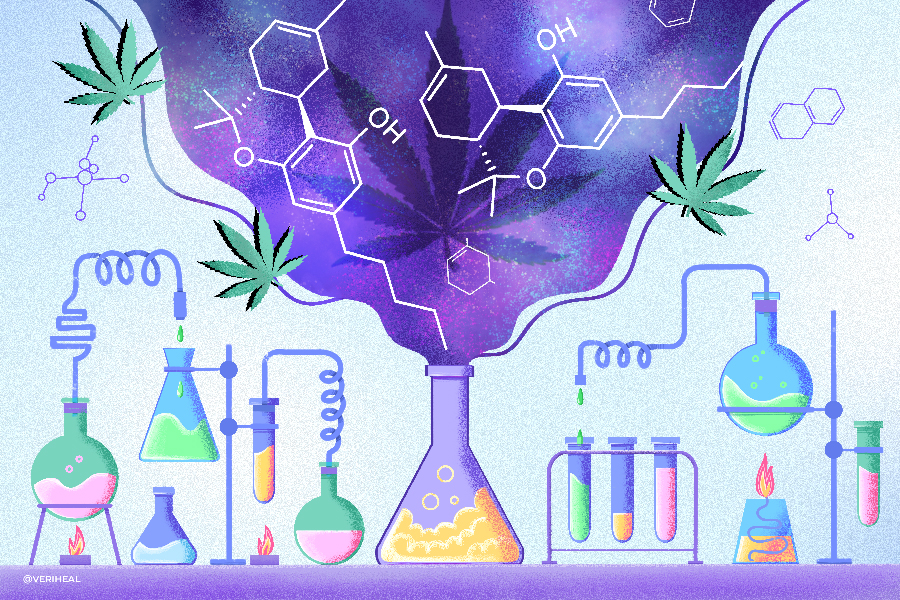Synthetic cannabis and cannabinoids have been connected to adverse effects time and time again. While completely manmade products like spice have been proven to have harmful effects, there’s less known about a rapidly emerging class of semi-synthetic cannabinoids that can be synthesized from hemp-derived CBD, some of which are also found in small amounts naturally. Examples of these are delta-8 THC, delta-10 THC, and HHC.
When it comes to synthetic or semi-synthetic cannabinoids, consumers are often unaware of the potential risks that come with consuming such forms of cannabis. Now, Project CBD is warning people about these potential risks.
Cannabis and Chirality
Chirality is described as a means by which an object or molecule cannot be superimposed on its mirror image by any translations or rotations. In other words, chirality is a property of asymmetry where an object or molecule is considered “chiral” if it can be distinguished from its mirror image. But what does this have to do with cannabis? Well, Dr. Matthew Elmes from Project CBD explains that cannabinoids are chiral—which means that cannabinoids can be distinguished from their mirror-image versions (the man-made versions).
Dr. Elmes goes on to explain that the cannabinoids produced naturally by the plant “exist as only a single chirality” and that when cannabinoids are made by humans to mirror the image of the structure of a compound, like cannabidiol (CBD) or tetrahydrocannabinol (THC), the natural and synthetic cannabinoids can be differentiated, both by minor changes in molecular structure and by the effect it has on the body. The doctor states that “it’s become clear that the chirality of cannabinoids is indeed an important factor influencing their effects in the body.”
Chirality is said to be an organic process rooted in the elements of geometry and is often used to describe situations where mirrored objects (or cannabinoid compounds) do not match up as a true mirror image would. The Project CBD report explains that synthetically produced cannabinoids could turn those compounds into better therapeutics, but they could also unleash hidden dangers.
Dr. Elmes states that there is not enough research to determine whether there are any potential pitfalls of the “unusual chiral permutations of these compounds.” He adds that federal regulations have failed to address the potential risks of making synthetic cannabinoids that are not true mirror images of the natural compounds.
When scientists try to create a mirror image of cannabinoids, they are chiral because the original can be differentiated from the man-made. Since there are slight differences, yet distinguishable ones, it is only logical to assume that there would be differences in their impact on the body—which is exactly the point that Project CBD is trying to get across.
Why You Should Get Your Medical Marijuana Card
Veriheal has satisfied millions of patients nationwide by giving them access to these benefits
- Larger purchase limits
- Peace of mind
- Enhanced legal protection
- Access to higher potency strains
- Save up to 25% on cannabis purchases
- Skip the line at the dispensary
However, one cannot be sure whether these differences in impact will be good or bad. For example, CBD is often preferred over THC for medicinal purposes due to the lack of intoxication. However, Dr. Elmes explains that a man-made version of CBD could cause intoxicating effects in humans.
The Potential Risks of Synthetic Cannabinoids
Now that we are aware that the chirality of a molecule can affect how the compound interacts with our bodies, more definitive research needs to be conducted since the currently available data on non-true image cannabinoids, or synthetic cannabinoids, is still quite sparse. Project CBD warns people of their potential “disparate effects in humans or potential for toxicity.”
At the same time, Project CBD states that it is possible for these compounds to have the potential to have “unique beneficial properties,” but that is exactly why “chirality is something that scientists need to pay a lot of attention to while developing new medicines.” The slightest differentiation could make the compound either significantly risky to consume or especially beneficial.
Synthetic Cannabinoids vs. Synthetically Produced Cannabinoids
Dr. Elmes explains that while it may be unlikely for these man-made cannabinoids to have serious negative effects, “the possibility shouldn’t be discounted because the truth is that we really don’t know yet.” Examples of these negative, or adverse, effects include increased agitation, irritability, elevated blood pressure, abnormalities in heart rhythm, etc.
Additionally, Project CBD details how it is important for people to understand the significant difference between synthetic cannabinoids and synthetically produced (i.e., semi-synthetic) cannabinoids. Synthetic cannabinoids include the likes of K2 and spice, which do not exist in nature and tend to be more unpredictable and dangerous.
However, synthetically produced cannabinoids like delta-8 THC are made by creating the exact same molecule that the cannabis plant has—but instead of being grown on a plant, it is made in a tube. It is these replicas that have the potential to become better therapeutics “as long as there are appropriate checks in place to confirm adherence to clean practices and ensure adequate purity of the product.”
Regardless of the risks associated with synthetically produced cannabinoids, it is important to understand that synthetic cannabis, like K2 or spice, should be avoided at all costs, while synthetically produced cannabinoids can be consumed with caution. According to Dr. Elmes, “It’s only a matter of time before non-natural chiral versions of cannabinoids enter the market,” which can be a good thing if they are equally or more effective therapeutics. These will also be cheaper and easier to produce and purchase.
“Agricultural cannabis will likely remain the predominant force within the industry, but synthetically produced cannabinoids will inevitably claim a significant share of the market in the coming years,” explains Project CBD. These products could be cheaper and more effective if the science is perfected, but they also pose risks. As Dr. Elmes said, we can’t be sure about their efficacy until more research is conducted and regulations are imposed to protect consumers against potentially adverse products.
Author, Share & Comments
















